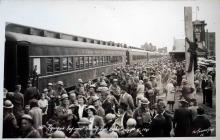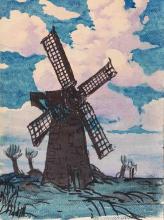The Windmill and the Teenaged Nazi: Windmills on the Mind
Watch the video!
In this video you will find out more about the life of George Cassidy. You will also learn more about the wartime contribution of the Algonquin Regiment.
-
 00:00:00 - 00:00:47
00:00:00 - 00:00:47This voice-over is accompanied by a sequence of images showing various events relevant to the history of the Algonquin Regiment.
“From the second the Algonquins landed on Juno Beach in July of ‘44, the clock was ticking and the pressure was on.
These inexperienced soldiers from Ontario’s Northland had to face some of the toughest of the German panzers in some of the most brutal of battles.
But they’d shown their mettle before.
In World War One.
The 159th Battalion.Northern Ontario had put out the call, and woodsmen from Temagami, miners from Cobalt, and Cree guides from James Bay, answered that call. These men of the north fought with courage in battles whose names have been seared into the Canadian imagination: Ypres, the Somme, and Vimy Ridge.
-
 00:00:48 - 00:01:51
00:00:48 - 00:01:51Fast-forward to World War Two, and the 159th are now the Algonquin Regiment, mobilized in 1940, shipping overseas in 1943.
And they got their baptism of fire during the fighting to close the Falaise Gap.
The Algonquin Regiment’s Major George Cassidy describes the German retreat up the Falaise Road, the lines of German prisoners like “ huge grey caterpillars undulating over the hills … (as) far as the eye could see lay the Valley of Desolation, palled in smoke from a thousand fires, alive with the stench of dead and burning flesh. Through the valley and beyond it, back along the battered road to Caen, the eye of the imagination could see once more the dust-laden air, shimmering in the August sun, and in that dust, swimming up to face us again, the shapes of those we had had to leave behind?”
As the heat of August gave way to the rains of autumn, the Algonquins headed to the waterlogged Scheldt.
-
 00:01:52 - 00:02:51
00:01:52 - 00:02:51The marshlands of Belgium were a long way from the silver town of Cobalt where Cassidy had been teaching high school before the war. It was a rough go. By the time the battle for the Scheldt was over, the Algonquins had been in Europe for 97 days; they’d logged 77 days of battle, with 816 casualties. And Cassidy was there through it all, wounded in Belgium, back in service in Holland, and finally receiving the Distinguished Service Award for Bravery.
He returned to Cobalt after the war. A keen artist, he had a deep love of the rugged landscape of the north, even accompanying A.Y. Jackson of the Group of Seven on a painting excursion. Cassidy also authored and illustrated a history of the regiment, a book entitled Warpath: The Story of the Algonquin Regiment 1939-1945.


